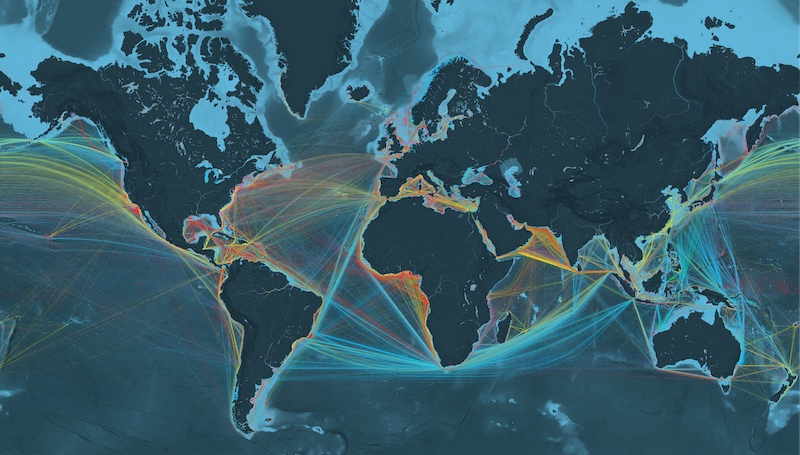Bharatvarsh, India, has been the center of maritime activity in the Hind Mahasagar region since the medieval ages. What is now a recuperating naval power – was once a powerful naval force which ruled nearby island nations during the times of King Ashoka.
A lot happened between now and then. The Mughals came, made India a minuscule naval power, came the British who built their own navy from resources here. Well, both these empires have since been destroyed and are long gone now.
The dominion of the Indian Ocean region is back in the hands of Hindus once again. However, challengers have arrived on the scene. In the heydays of Cold War – there were only two. In the multi-polar world, there are more players than one could say off hand. You can neither write off UK, nor France nor a power like Russia off completely the Indian Ocean region.
And then there are the big boys all of whom want to make IOR their backyard. The biggest boy is the USA, they even have a clubhouse here. NSF Diego Garcia. India is a far-off runners up. China follows the duo, them having the excuse of having their biggest maritime trade route running through the Indian Ocean.

So how does India gain an upper hand in this seemingly complex game of naval dominance?
As always, there are no easy answers to this question. But an answer to this exists depending on what endgames we are playing at. So let us enumerate the possible endgames.
- Complete dominance in the IOR. Freedom of navigation to no other Navies
- Partial domination of IOR with USA and China as peers
- Playing second fiddle to powers like USA and China
Endgame 1: Complete dominance of IOR
While most argue that it is impossible for India to dominate such a vast body of water on her own at the present with the resources she has at the present, I would like to see this from a different point of view. Nothing is impossible, just difficult. The difficulty, in this context lies in how much we are willing to sacrifice for achieving the objective. At the moment, complete domination of IOR is not important to us because there are more worthy geostrategic objectives which lie before us.
A few of these objectives which get higher priority, some of which we would like to tick off first from our checklist are :
- Complete cessation of hostilities with Pakistan. Overt and Covert
- Settlement of the border issue with China
China is the single largest reason why we do not control the Indian Ocean Region in the manner we desire. India is a country which has to balance its resources and budget allocation. It does not have the vast coffers of the United States, neither does it have the privilege of collecting huge sums as interests and dividend from almost all countries in the world. Therefore its military has to balance between maintaining existing zones of defense and expanding to new zones. Whenever we invest money in our naval capabilities, China increases its ‘salami slicing’ activity in our North Eastern regions, that compels us to again abandon our naval restructuring efforts and re-dedicate the remaining resources in countering China. This has to stop if we have to focus on the Indian Ocean region without the distraction of Galwan-like events.
Pakistan has a navy. However, compared to the Indian Navy, it might as well be a flotilla of gunboats. The Pakistan navy does not have any realistic chances of challenging India in the Indian Ocean region. However, it can always perform pin pricks and keep us distracted for a very long time. Furthermore, any hostility with Pakistan on land borders will eventually culminate to hostilities in the sea. For us to be able to expand peacefully into the IOR, we need peace, on both our eastern and western fronts. The enemy understands this too well, and for the predictable future, they will keep us busy on our land borders.
However, even if it so happens that both these objectives are reached, it does not mean we will be able to dominate the IOR by any standards. The above may just provide us a good starting point from which we can start increasing the number of Frigates, Destroyers, Submarines and Aircraft carriers. We would still have the problem called US Navy. We would still have the problem of the Chinese Navy. While the Chinese Navy would like to have their presence in Indian Ocean covertly, the US is more a fan of FONOP (Freedom of Navigation Operations). These do not stop with increasing number of naval units. However, policy and punitive actions will.
Policy and Punitive Action
India needs to retaliate militarily to events which would have had military implications had India done the same in the territories of other countries. There needs to be a clear policy which defines the rules of engagement in case of FONOP operations by other nations. Ships should be chased away with gunboats, should they enter our Exclusive Economic Zone. We should not seek standoffs, but not be afraid to do so once challenged by our adversaries.
Challenges
Diego Garcia Naval Supply Facility in the Chagos Archipelago will present a unique challenge to future Indian supremacy in the British Indian Ocean Territory. The island belongs originally to Mauritius, usurped by the UK since colonial times and is now home to an American naval base. Should India decide to spread her wings over the Indian Ocean Region, Diego Garcia will form the tip of the pole with which the Americans will poke India.
Coco Islands were originally Indian territories at the dawn of Indian Independence. The blunder prone first Prime Minister of India, Neheru, gifted the islands to Myanmar. The Myanmarese in turn allowed the Chinese to build SIGINT facilities on these, from which they have been tracking Indian naval activity for two decades. New satellite images also point out that the Chinese have been increasing their activities on Coco. The airstrip has been modified to accommodate larger supply planes and possibly bombers, all places in proximity to Indian strategic locations like Vizag.
The Hambantota port, which the Chinese snatched from the Sri Lankans using their dirty tricks department also known as debt repayments, together with the Coco Islands facility form a part of the String of Pearls encircling Indian naval presence in the Indian Ocean region.
Therefore we see that a mere coercive policy against the military class of vessels entering Indian ocean cannot be our only resort when we seek to completely dominate the Indian Ocean Region. In addition to building and launching naval vessels of various sizes and capabilities ourselves, there is a dire need to build up the existing Strategic locations from which the Indian military establishment can monitor the movement of other Navies, can launch assets against them and re-supply them in case of any hostile eventualities. It would be impractical otherwise to even think of being able to monopolize this vast stretch of Ocean which spans seventy million square kilometers.
Opportunities
As gloomy as it may seem, reality is fortunately a little better than that. It is untrue that we are devoid of any opportunities to counter these challenges. We also do not lack strategic depth, should we decide to exploit the advantages nature and post-colonial politics has afforded us. Lakshwadeep islands, Maldives and Nicobar Islands can be part of a reverse String of Pearls approach which India can use to encircle the Chinese String of Pearls.
Work has begun in earnest to fortify the Andaman and Nicobar Islands. A tri-services command, the Andaman and Nicobar Command has been set up to counter the threats emanating from South East Asia and the Strait of Malacca. We are building up significant assets consisting of nuclear missile system, naval warships and Landing Platform Docks.
China is well aware of the designs we have in place for its navy. Should shove come to push one day, it is certain that the geostrategic assets combined with the tactical assets we already have in place would be able to give them a drubbing. USA is another story.
However, let us hope and strategize for the day that may not be far when both the US Navy and Chinese Navy will be looking up to India for granting safe passage through this vast ocean so aptly named — Hind Mahasagar.
